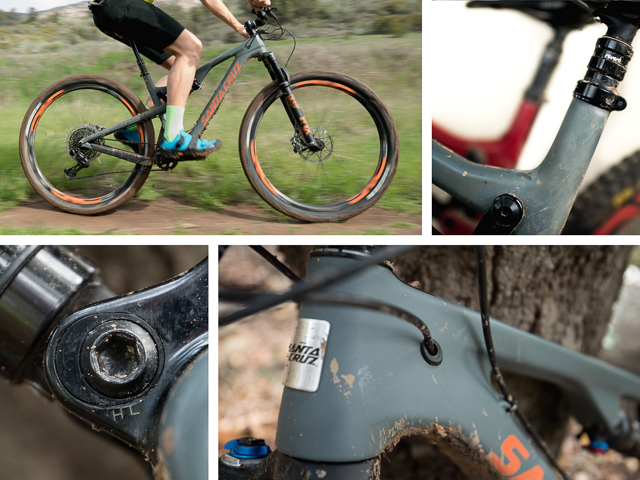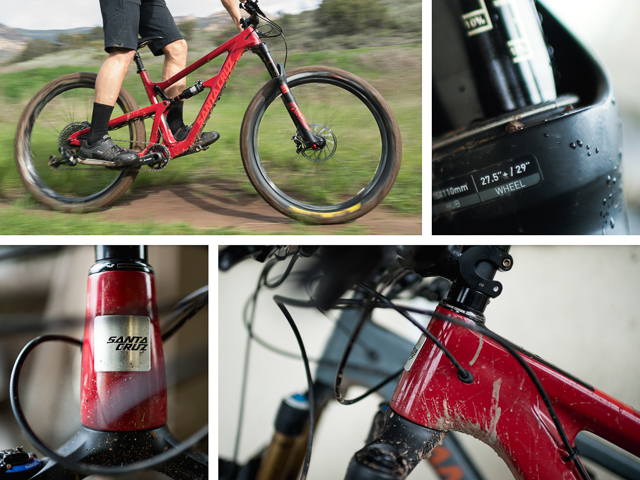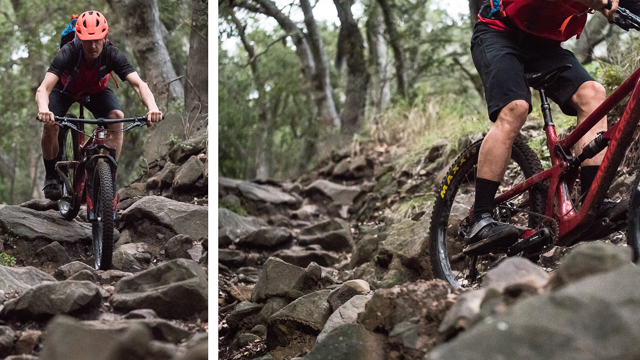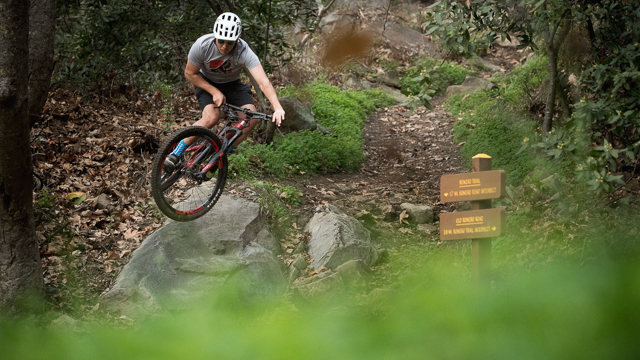Competitive Cyclist Santa Cruz Hightower Vs Tallboy Review
Reviewed: Santa Cruz Tallboy vs. Hightower
Wherever in that location are siblings, in that location are bound to be rivalries. These rivalries can be, and oft are, a source of motivation for both parties to push ever harder, raising the bar in the process. Simply they can also upshot in hurt feelings. Santa Cruz's lineup has been cultivating its own set of sibling rivalries for generations now, which has made for some distress lately as one sibling, the Hightower, has largely stolen the spotlight that the Tallboy once enjoyed. However, we had it on good authority that information technology was a mistake to ignore the latest Tallboy, so naturally, we put both the 2017 models to the test to see which i shines brightest.
Tallboy
That the latest Tallboy has not received its due since its release in the summer of 2016 is a cruel injustice. The original 2009 Tallboy is widely regarded as the 29-inch trail bike that blew the doors off the entire genre. That reputation is due mostly to quick-treatment geometry that dispelled the idea that big wheels meant limousine-inspired ride. Nevertheless the marketplace has changed, and the Tallboy has some serious competition.

As expected, the Tallboy'southward details are nicely executed. The adjustable upper link
allows for the use of 27.5 Plus and 29 inch wheels, while the internal cablevision routing
is incredibly convenient.
Its 110mm of travel, paired to a 120mm fork, positions it squarely within one of the most hotly contested market segments of the past two years—namely, curt-travel 29ers. The 68-degree head bending is relaxed, but it's also on the more restrained end of a segment that'due south been getting decidedly more extreme. Ditto the relatively short 17in chainstays. Compared to bikes like Evil'southward Post-obit, Pivot's Mach 429 Trail, Yeti's SB4.5c, and Ibis'due south Ripley LS, the Tallboy looks fairly conservative—but actually, that's a skillful thing.
Many of the bikes in the Tallboy'due south travel range handle like short-travel enduro sleds—a byproduct of the obsession with ever lower, longer, and slacker frame geometries. While the Tallboy certainly pushes in that direction, it'due south clear that Santa Cruz'due south designers exercised a caste of restraint, focusing on poise and residue rather than exploring the physical limits of the brusk-travel platform. In that regard, it'due south probably most comparable to Niner's excellent JET ix RDO. Although hyper-aggressive treatment is personally appealing, bikes that push this envelope tin can invite the rider to charge full-diameter into sections that rapidly expose the limits of the bike'southward intermission, occasionally with disastrous results. One can't aid but applaud Santa Cruz for maintaining the Tallboy's civilized demeanor. It allows the passenger to get away with a lot, but doesn't taunt the rider for not diving in over their head.

Point the Tallboy upwards, and information technology will happily oblige, rewarding the rider with a
firm feel at the pedals and enough room to become comfy.
Hopping aboard the Tallboy, the balanced position is incommunicable to ignore. The rider position is most perfectly centered, allowing for weight shifts with minimal endeavour. As compared to the previous Tallboy, the seat tube angle is more upright. In conjunction with a roomier reach measurement, it makes the Tallboy an inspiring climber. This trait is enhanced past the updated VPP suspension, which is noticeably more supportive in the midstroke than the previous version. The changes have also improved the Tallboy's descending, allowing it to ride higher in the travel, keeping more than stroke on hand for dealing with big impacts. Information technology'southward also worth noting that the Tallboy is built effectually modernistic component standards, including 27.5 Plus tire compatibility. This is certainly not a curmudgeon's cycle.

At that place are more aggressive bikes in its grade, but the Tallboy isn't afraid to
indulge the occasional wild impulse —a trait profoundly appreciated by the author.
One wouldn't fault it for a longer-travel bicycle, merely it handles chunky terrain, muting most all mid-amplitude churr, and rewarding passenger input with simply enough feedback to give good tire feel. Perhaps the near pleasant surprise was its cornering. Put only, the Tallboy absolutely track. Information technology'southward low plenty to exist planted, supple enough to be grippy, and balanced enough to exist completely intuitive, without any of those traits sacrificing the classic trail bike handling.

When long rides in varied terrain are on the menu, the Tallboy is an easy choice.
So then, the new Tallboy is a astounding trail bike and a nearly perfect steed for endurance races similar the BC Bike Race—merely how does it stack upwards against its bigger brother?
Hightower
Injustices and hurt feelings bated, it's understandable that the Hightower gets so much attending. Afterwards slowly gaining steam, the past year has seen the long-travel 29er segment explode and the Hightower has become a serious contender in this highly competitive category. And much similar the Tallboy, the Hightower stands out for its restraint in a category that seems hell-bent on pushing the geometric envelope.

Like the Tallboy, the Hightower's internal cable routing is as good as it gets.
It also benefits from 27.5 Plus and 29 inch-compatibility,
made possible by the adjustable upper link.
Coming off the Tallboy, you lot immediately notice the Hightower'southward family unit resemblance. The reach measurement is identical, and although the seat tube angle is steeper, the added travel and sag place the rider in essentially the same position relative to the rear wheel. The Hightower is firm at the pedals, which completes a package that climbs similar information technology has something to prove, at least as compared to the residual of its class. In short, it represents something of a sweet spot between the nearly ambitious big-wheeled trail bikes and their short-travel counterparts. It also allows enough adjustments in setup to claiming the very best of its competitors.
At 135mm of rear travel, the Hightower immediately invites comparisons to Pivot's Switchblade and Yeti's SB5.5c, both of which are fantabulous machines and worthy adversaries. In comparing, the Switchblade boasts both longer accomplish and shorter chainstay measurements. The SB5.5c is also slacker, and information technology has more than travel, although the reach is slightly shorter. Both send with longer travel forks than the Hightower's 140mm unit, although the Hightower accepts a 150mm fork, should you lot desire to level the playing field. Much like the Tallboy, the Hightower finds itself in a competition where it looks to exist lacking but a flake, at least on the surface. Dig deeper, and you'll find that the Switchblade and SB5.5c are, in essence, western-style enduro race bikes. Although it's certainly enduro race-worthy, the Hightower's focus is slightly broader, inviting comparisons to the Tallboy's near ambitious competitors, like the SB4.5c or the Following, where it stacks upwardly extremely favorably. The upshot is that the Hightower affords a noticeable buffer when pushed to the limit in rough terrain, where some of the shorter travel bikes run out of legs.


When faced with hairy terrain, the Hightower inspires accented confidence,
even more and then than the geometry chart might signal.
Where the Hightower gains a serious advantage against its competition, bigger or smaller, is cornering. While the Tallboy is low, the Hightower is very low—noticeably lower than the Switchblade or SB5.5c. Information technology's roughly the same height as the Evil Post-obit in its "high" setting, merely when factoring in the added travel, the Hightower's ride height is lower than even this basis-hugging Following. The tradeoff, every bit ever, is reduced ground clearance, but personally, information technology's 100% worthwhile for such instinctive handling. Information technology helps that the pause is both supple and supportive, and that the chassis has a finely-tuned flex that keeps it tracking smoothly. Its handling is a one-half-pace less ambitious than the Pivot Switchblade, due mostly to the slightly steeper and shorter forepart, but it remains stable, almost equally so, when pointed through hairy stone sections at speed. While the overall differences between these bikes are fairly minor, the Hightower's handling gives information technology more than of the feel of a precision instrument. The cyberspace event is something like riding a pair of giant slalom skis—etching large radius, high-speed arcs—and information technology's absolutely fantastic.
But the question remains—between these 2 Santa Cruz standouts, which ane to option?
The Verdict
Sibling rivalries often serve to highlight family resemblances, and this is just such a case. Both bikes take something of a non-conformist streak. They're both aiming to be the most refined version of their respective selves, while much of their competition seems focused on pushing measurements every bit far every bit possible. That said, the difference betwixt the two is more pronounced than a geometry sheet might indicate. The Hightower continues to get ameliorate equally speeds increase. Accordingly, it asks that the rider look further alee and drive the bike to really make it sing. The Tallboy doesn't crave the same degree of intent from the rider, which makes it incredibly inviting. Instead, it prioritizes like shooting fish in a barrel treatment over outright stability, and even so leaves enough in reserve to arrange for line selection blunders or the occasional desire to get wild.

The author immediately clicked with the Hightower. It made a strong enough
impression that he bought the review bike on the spot.
And so which sibling reigns supreme? Full disclosure: I purchased the Hightower that was supplied for this review. It was a sweet bargain, to be sure, simply that didn't make much difference—the Hightower immediately felt right, and I had to have ane. Then again, that decision was influenced by intended use, which will include racing enduro and twenty-30 lift or shuttle days this flavor. In light of those considerations, the Hightower is the obvious choice. For a passenger more than focused on trail riding and the occasional XC race, and who wants merely plenty forgiveness to push their limits, the Tallboy a true standout. Just as chiefly, it's absolutely worthy of sharing the spotlight with its star sibling.

In this sibling rivalry, it's difficult to option favorites. Both bikes are outstanding;
the question is which 1 best suits your needs.
Related
First Impressions: Pivot Switchblade & Firebird
Outset Impressions: Niner RIP vs JET 9
Reviewed: Evil Bikes Insurgent
Battle of the SuperBikes: Yeti SB5.5c vs. SB4.5c
First Impressions: Ibis Mojo 3
Shop
Santa Cruz Tallboy
Santa Cruz Hightower
Store All Mountain Bikes
Source: https://www.competitivecyclist.com/learn/reviewed-santa-cruz-tallboy-vs-hightower
0 Response to "Competitive Cyclist Santa Cruz Hightower Vs Tallboy Review"
Enregistrer un commentaire